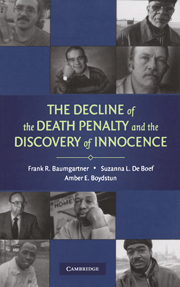Book contents
- Frontmatter
- Contents
- List of Tables
- List of Figures
- Acknowledgments
- 1 Innocence and the Death Penalty Debate
- 2 The Death Penalty in America
- 3 A Chronology of Innocence
- 4 The Shifting Terms of Debate
- 5 Innocence, Resonance, and Old Arguments Made New Again
- 6 Public Opinion
- 7 The Rise and Fall of a Public Policy
- 8 Conclusion
- Epilogue: Individuals Exonerated from Death Row
- Appendix A New York Times capital punishment coverage, 1960 to 2005
- Appendix B Description of Data
- Notes
- References
- Index
6 - Public Opinion
Published online by Cambridge University Press: 05 September 2012
- Frontmatter
- Contents
- List of Tables
- List of Figures
- Acknowledgments
- 1 Innocence and the Death Penalty Debate
- 2 The Death Penalty in America
- 3 A Chronology of Innocence
- 4 The Shifting Terms of Debate
- 5 Innocence, Resonance, and Old Arguments Made New Again
- 6 Public Opinion
- 7 The Rise and Fall of a Public Policy
- 8 Conclusion
- Epilogue: Individuals Exonerated from Death Row
- Appendix A New York Times capital punishment coverage, 1960 to 2005
- Appendix B Description of Data
- Notes
- References
- Index
Summary
In previous chapters we documented shifts in how Americans discuss the death penalty. In particular, we showed the sharp rise of the innocence frame in the mid- to late 1990s and how this new focus of attention redefined the entire debate. The shift in focus prompted citizens to consider the issue in new ways, leading to the potential for significant changes both in aggregate public opinion and in public policy. Changes in opinion and policy do not come easily in a status quo–oriented system, especially in cases like the death penalty, in which beliefs are firmly rooted in moral and religious viewpoints and in which policy plays out these views (Alvarez and Brehm 2002; Baumgartner and Jones 1993; Kingdon 1984; Poole and Rosenthal 1984). As we show in this chapter, public opinion on the death penalty is remarkably stable. The practice of sentencing criminals to death is as entrenched a policy in American political history as one could imagine, in large part because Americans have long supported the practice. And yet with enough momentum, attention cascades can produce dramatic shifts in opinion and policy, even in the hard case of the death penalty.
In Chapter 7, we examine the effects of attention cascades on policy as measured by the number of death sentences each year from 1961 to 2005. Here, our focus is on aggregate public opinion, and our time orientation is more fine-grained.
- Type
- Chapter
- Information
- The Decline of the Death Penalty and the Discovery of Innocence , pp. 166 - 199Publisher: Cambridge University PressPrint publication year: 2008



